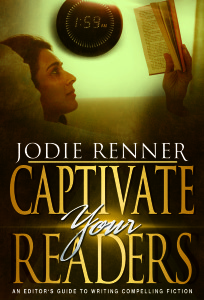Use Attitude When Introducing Characters
by Jodie Renner, editor and author @JodieRennerEd
To celebrate the release of her third writing guide, Captivate Your Readers, Jodie has priced it at 99 cents for today only and will also be giving away 4 electronic copies – your choice of mobi (for Kindle), ePub (for other e-readers), or PDF – of this book, in exchange for an honest review by the end of March. Enter to win in the comments below.
A sure sign of a fiction writer who’s still learning his/her craft is when a character comes on the scene for the first time and the writer stops the story to describe the character from head to toe – height, build, hair color, eyes, other facial features, and all the details of their clothing, including colors, down to their shoes. Then the story picks up where it left off and carries on.
My latest writing guide, Captivate Your Readers, devotes four chapters to how to introduce and describe characters in a natural, intriguing way. The basic message is to stay in the protagonist’s viewpoint when introducing him, and describe other characters through the POV of the character observing them, not neutrally, as the author stepping in. Here, I’ll be discussing effective techniques for describing other characters through the observations and attitudes of the viewpoint character (most often the protagonist).
Whether you’re describing the main character or someone he/she is observing, readers don’t need or welcome a list of every physical attribute and what they’re wearing – readers want a quick glimpse into their personality and character, how they carry themselves, how they enter a room, the effect they have on others. The readers can easily fill in any details themselves – if they want to. As a reader, I want a general impression but not every tiny detail – I’m more concerned about what’s happening, the interaction between the characters.
Which brings me to my next point – the protagonist (or other POV character) is busy interacting with that person, in a scene with some tension (at least there should be!), so they don’t have time to detail everything the person is wearing and think about the color of their hair and eyes, their height, etc., unless these are details that really stand out. If the person is very tall or very short, very heavy or thin, overbearing or timid and apologetic, bombastic or shy, these are details the observing, viewpoint character will register right away and take note of, even react to internally. The most important thing is to keep it real – what would the POV character really be thinking at the time?
~ Show the essence of the character and his effect on those around him.
Rather than giving readers a long, detailed police line-up description of a character’s height, build, facial features, and clothing, it’s best to just show an immediate impression of the character, including his personality or state of mind, as perceived by the viewer, through a few well-chosen details. Then let the readers imagine the rest themselves.
Here’s an example of just giving the relevant info, and from the character’s point of view. This is from LJ Sellers’ Agent Jamie Dallas thriller, The Target. Cortez, a young police detective, is investigating a murder with his senior, an older detective named Hawthorne. We’re in Cortez’s point of view.
The older detective stood, so Cortez did too. Even with his rounded shoulders, Hawthorne’s Ichabod-Crane body type made Cortez feel short at five-seven. Next to his father and cousins, he was the tall one.
These three sentences give us quite a bit of information about the two characters, with almost no interruption to the action, and we stay firmly in the thoughts and observations of the character.
In The Shield, by Lynn Sholes and Joe Moore, the main character, a scientist, who’s a bit intimidated, watches as two powerful Russians enter the scene.
The general appeared quite physically fit, even for his age. The casual, open-collared shirt hid little of his muscular build, no doubt from years of setting an example as a leader of the Russian Army
“How was your flight?” asked Ivankov. Unlike the general, the Russian banker was portly and balding, and bore the veined, red nose of a heavy drinker. He, too, was dressed casually.
In these two short paragraphs, we get quite a complete picture of these two guys (who are minor characters in the story), including info on their past, lifestyle, and characters. We don’t really care what they were wearing, exactly, as we’re eager to find out what happens next in this power meeting. And it doesn’t feel like the author interrupting the story to describe these people; it feels like the character observing them.
In her novel, Hot Rocks, Nora Roberts describes the appearance of a stranger like this:
A heroic belch of thunder followed the strange little man into the shop. He glanced around apologetically, as if the rude noise were his responsibility rather than nature’s, and fumbled a package under his arm so he could close a black-and-white-striped umbrella.
Both umbrella and man dripped, somewhat mournfully, onto the neat square of mat just inside the door… He stood where he was, as if not entirely sure of his welcome.
We readers might all visualize this man a bit differently, to suit our own ideas of what he should look like, but we get an immediate impression of his timidity and hesitancy, which is all we really need at this point.
And here’s a depiction of a prematurely aging middle-aged woman that strikes to the core, with just a few masterful brush strokes. In Moonlight Mile, instead of saying, “She looked old for her age, with her white hair and wrinkles,” Dennis Lehane describes her like this:
I did some quick math and guessed she was about fifty. These days, fifty might be the new forty, but in her case it was the new sixty. Her once-strawberry hair was white. The lines in her face were deep enough to hide gravel in. She had the air of someone clinging to a wall of soap.
~ Show the viewpoint character’s feelings and reactions to the character he/she is observing.
Also, work in the viewer’s emotional reaction to the character. Is the narrator character impressed? Intimidated? Fearful? Attracted to them? Disgusted or repulsed?
For example, Brad Parks, in The Girl Next Door, describes the first-person narrator’s feelings about a love interest:
…in addition to being fun, smart, and quick-witted—in a feisty way that always kept me honest—she’s quite easy to look at, with never-ending legs, toned arms, curly brown hair, and eyes that tease and smile and glint all at the same time.
By contrast, the protagonist of Dennis Lehane’s Moonlight Mile describes a spoiled rich kid who leaves victims in his wake without a second thought, as Mummy and Daddy will clean up after him. Here, the disgust of the observer character comes through loud and clear:
…Brandon wasn’t your run-of-the-mill rich kid asshole. He worked double shifts at it.
The investigator paid to spy on him goes on to describe the kid’s clothes:
Brandon wore a manufacturer-stained, manufacturer-faded hoodie that retailed for around $900 over a while silk T with a collar dragged down by a pair of $600 shades. His baggy shorts also had little rips in them, compliments of whichever nine-year-old Indonesian had been poorly paid to put them there.
Lehane’s astute investigator later describes a trophy-wife stepmother:
She had the look of a woman who kept her plastic surgeon on speed dial. Her breasts were prominently displayed in most of the photos and looked like perfect softballs made of flesh. Her forehead was unlined in the way of the recently embalmed and her smile resembled that of someone undergoing electroshock.
All of these descriptions paint a quick picture of the effect these characters have on the viewpoint character, the POV character’s immediate impression of them, without listing their height, build, hair color, and clothing, like a police line-up.
Do you have any examples or tips to add?
 Jodie Renner is a freelance fiction editor and the award-winning author of three craft-of-writing guides in her series An Editor’s Guide to Writing Compelling Fiction: Fire up Your Fiction, Writing a Killer Thriller, and Captivate Your Readers. She has also published two clickable time-saving e-resources to date: Quick Clicks: Spelling List and Quick Clicks: Word Usage. You can find Jodie at www.JodieRenner.com, www.JodieRennerEditing.com, at The Kill Zone blog alternate Mondays, and on Facebook, Twitter, and Google+.
Jodie Renner is a freelance fiction editor and the award-winning author of three craft-of-writing guides in her series An Editor’s Guide to Writing Compelling Fiction: Fire up Your Fiction, Writing a Killer Thriller, and Captivate Your Readers. She has also published two clickable time-saving e-resources to date: Quick Clicks: Spelling List and Quick Clicks: Word Usage. You can find Jodie at www.JodieRenner.com, www.JodieRennerEditing.com, at The Kill Zone blog alternate Mondays, and on Facebook, Twitter, and Google+.
Tweet: Use attitude when introducing characters. Here’s how: http://bit.ly/1F0zZUh @JodieRennerEd
The post Use Attitude When Introducing Characters appeared first on Elizabeth Spann Craig.



